1956
Stanley and Wright
213 Truman Street SE
Case study by Simon Sawyer
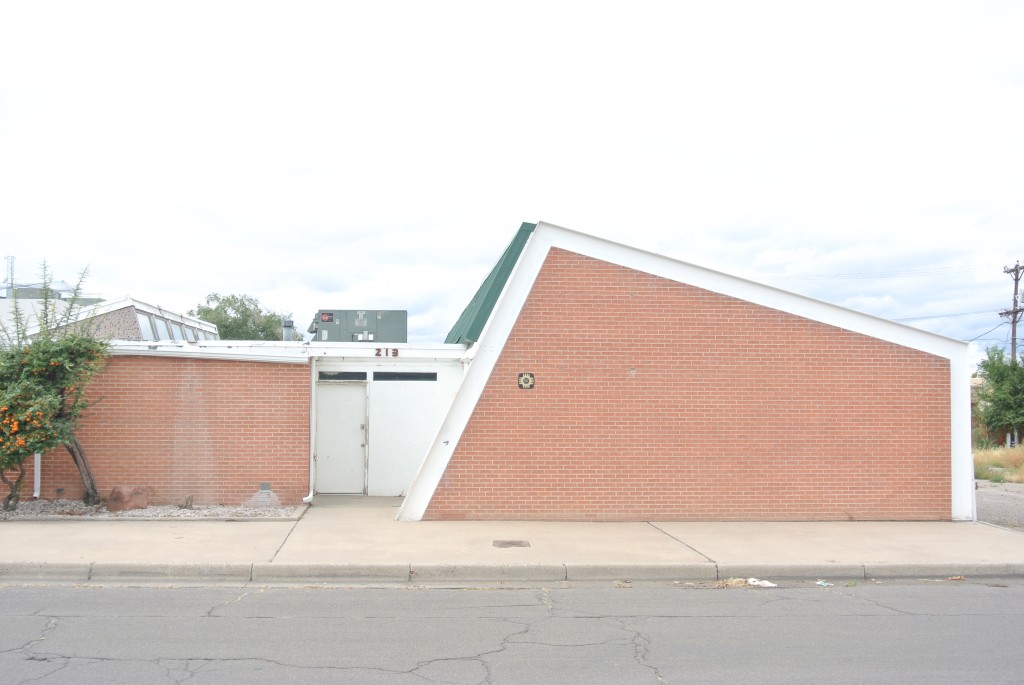
When the Solar Building, located at 213 Truman Street SE in Albuquerque, finished construction in August 1956, it became the first active solar heated commercial building in the world. The architects of this modest building – which nonetheless boasted worldwide importance – were the local firm of Stanley and Wright, a small, Albuquerque-based mid-century firm that especially focused on educational, commercial, and public projects. They designed the Solar Building to be the new office for the Bridgers and Paxton engineering firm. Bridgers and Paxton themselves devised the mechanical system that made their new headquarters so architecturally and technologically noteworthy.
Frank Bridgers and Don Paxton, principals of the engineering firm that bore their name, developed the idea for the Solar Building shortly after they established their firm in 1951. They subsequently conducted research that informed the design of the solar heating of their building over the next four years, preceding the start of construction in March 1956. Their intention was to build a structure that used the sun to warm their office during the winter months, controlling its climate. Upon completion, the Solar Building suggested the viability of their concept. The new office measured 8,300 square feet, with its heating system covering 5,000 square feet of its area. But when further construction expanded the building to almost double its size in 1962, the solar collector system went offline for over a decade, foreshadowing the mixed fortunes of solar power in the late twentieth century that this building’s history represents.1
The climate in Albuquerque perfectly suited the requirements for the creation of a solar heated building. During the winter months, Albuquerque received the maximum solar radiation in the whole of the United States. Moreover, with the city’s postwar boom in population and a remarkable increase in local defense work, Albuquerque boasted an atmosphere driven by creation, innovation and new technology. In this context, the Solar Building represented both a new engineering milestone in the use of renewable energy and an indicator of the intellectually sophisticated minds that Albuquerque was producing. Not just a modernist building in form, it also represented the new technological possibilities promised by modernism in the growing American Southwest. These promised futures proved more complicated from the very start. Ironically, after the completion of the Solar Building during the winter of 1956-57, Albuquerque’s January was reportedly the cloudiest month in National Weather Service history. But despite the cloudy weather over the season, the solar panels successfully worked.2
The mechanical system that supported the Solar Building’s heating system consisted of three components: collector panels, a water storage tank, and a water-to-water heat pump. The first of these made up a southern wall that cut dramatically through the center of the building at a 30-degree angle, encompassing 750 square feet of solar panels and designed to optimally receive the winter sun. Each of its individual panels included a glass pane and a black painted aluminum sheet backed with coiled copper tubes, a material that Bridgers and Paxton selected because of its rapid conductive ability. Those tubes were filled with water that circulated throughout the system. As the sun hit the solar panels, the copper pipes and water became heated, warming the building. Heated water entered the system’s second-major element, its underground, 6,000-gallon storage tank, where it remained until needed in the evening or on days without sufficient sun. The third major element of the system, its heat pump, activated when the temperature of the storage tank’s water fell below the temperature necessary to heat the Solar Building. This mechanical system made up the most noteworthy part of the building’s climate control scheme, certainly, but was only one component of a larger system that included direct solar heating, solar heating with the pump, evaporative cooling, and refrigerated cooling, as the seasons demanded.3
The building itself extends along the site in a series of six bays, defined by steel I-beams. Most visible on the northern façade, these beams follow three separate lengths to form the structural framework of the building’s primary mass, supporting the southern wall with its solar collector panels, the slanted roof, and the northern wall. In section, this approach creates an irregular geometric form for that portion of the building, consistent along its length. The main drafting rooms were located within this series of elongated bays. The associated mechanical equipment and meeting rooms were located in the extension of the building to the south, which sits lower than the northern half of the Solar Building, figuratively and literally ensuring that the solar panels would not be overshadowed.
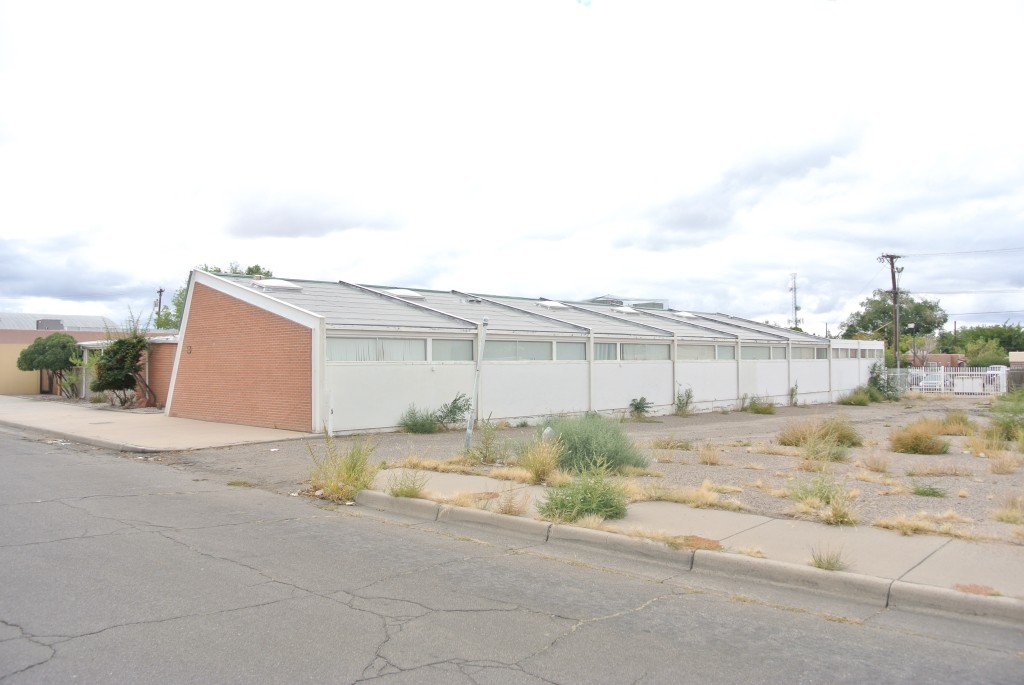
Despite all the accomplishments associated with the Solar Building, however, it received a mixed reception. Upon opening, it quickly gained fame in two of the most popular magazines in the postwar United States, Life and Popular Mechanics. Its appearance in Life came in the December 17, 1956 issue, in an article that recognized the building’s engineering accomplishment and provided a brief description of its solar heating system:
An odd-looking new office building in Albuquerque, N. Mex. Has one wall sheathed in glass and tilted to face the sun. The glass wall is a solar heating unit and the building, designed by engineers to house their offices, is the first commercial structure in the country to be heated entirely by the sun…. The building uses water in its heating system. Its glass wall is backed by hollow metal panels through which water circulates. The sun’s rays pierce the glass, strike the panels and warm the water, which flows though a conventional heating system. The glass traps the heat. An insulated storage tank of sun-heated water tides the building though sun-less days, when a special device extracts the last bit of heat from the circulating water. The designers believe the sun will keep their office at 72 degrees (Fahrenheit) even in the chilliest winter weather.4
The article described the building in layman’s terms and provided a very general indication of the engineering milestone that had been achieved. The importance of this article was not simply in the information it contained, however, but also in its presence in Life. Life was a major promoter of pop culture and consumerism during the golden age of capitalism. The products it promoted and articles it featured were tools that promoted the prosperity of the United States during the postwar era. These products heavily influenced the magazine’s wide readership. The Solar Building’s appearance in Life suggested the promise of a new technology in an era full of such innovations, but also stood as a representation of the intellectual ability of the United State and, in particular, the Southwest. Likewise, it suggested the movement towards a modernist society.
The Solar Building’s appearance in the November 1957 issue of Popular Mechanics described its use to a greater extent and in more detail. “SOLAR ENERGY keeps a small office building warm all winter long in Albuquerque and helps to cool it in summer. Outdoor temperatures in the winter drop well below freezing in Albuquerque and yet the temperature inside the building stays at a comfortable 72 degrees,” the article began, before providing a thorough accounting of the Solar Building’s systems.5 Similar to Life, the editors of Popular Mechanics, too, promoted the American Dream and postwar prosperity, as well as the innovations that grew from it. Indeed, in 1958, Popular Mechanics would become a subsidiary of Hearst Corporation, a multinational mass media group, resulting in the publication of even more articles relating to the rapid growth of the United States during this time. Together, these articles introduced the Solar Building to much of the growing American middle class, suggesting that this technology, too, was one of the new goods that one could purchase in this era.
Yet despite this auspicious start, the Solar Building would quickly find a much more humbling reality. Although it proved successfully able to heat itself and reduce energy costs during its first winter in operation, only a few years later its occupants ceased use of the solar heating system. With low fuel costs in the United States during the 1960s, the additional construction costs associated with solar heating could not be justified economically. When Bridgers and Paxton expanded the building in 1962, nearly doubling its size, they added a boiler, providing a more conventional heating system for their office and making the solar powered system redundant. The dilemma that the engineers experienced at this local scale also played out at a larger scale. Faced with the same tradeoff between innovative technology and costs, solar energy did not take off as Stanley and Wright and Bridgers and Paxton initially intended, and, after the initial flourish of media and public interest, the Solar Building did not receive wide attention for its engineering achievements, nor did it spawn imitators across the country.6
In many ways, the Solar Building was ahead of its time. The conditions of the 1960s meant that its most unique feature went unused for 12 years. When the politics of oil changed dramatically in the 1970s, however, solar power came back into vogue. In October 1973, the Organization of Arab Petroleum Exporting Countries (OPEC) proclaimed an oil embargo, raising the price of oil from three to twelve dollars a barrel in just five months. This rapid spike in the cost of oil dramatically increased energy costs for buildings, undermining the cost efficiency of traditional systems and again bringing attention to the feasibility of renewable energy sources, especially in the Southwest and Sunbelt region. Thus when, in 1974, renovations were again made to the Solar Building, this time the funding came from the federal government, through a National Science Foundation research grant focused on solar technology. This project revived and upgraded the system that gave the Solar Building its name, adding an ethylene-glycol water solution to its pipes, installing a new heat exchanger to transfer heat to water in the storage tank, and automating controls. The Solar Building’s importance to this growing technology went beyond the building itself. It also provided extensive information for a demonstration and research program that sought to put solar-assisted heat pump systems in wider use around the country.7
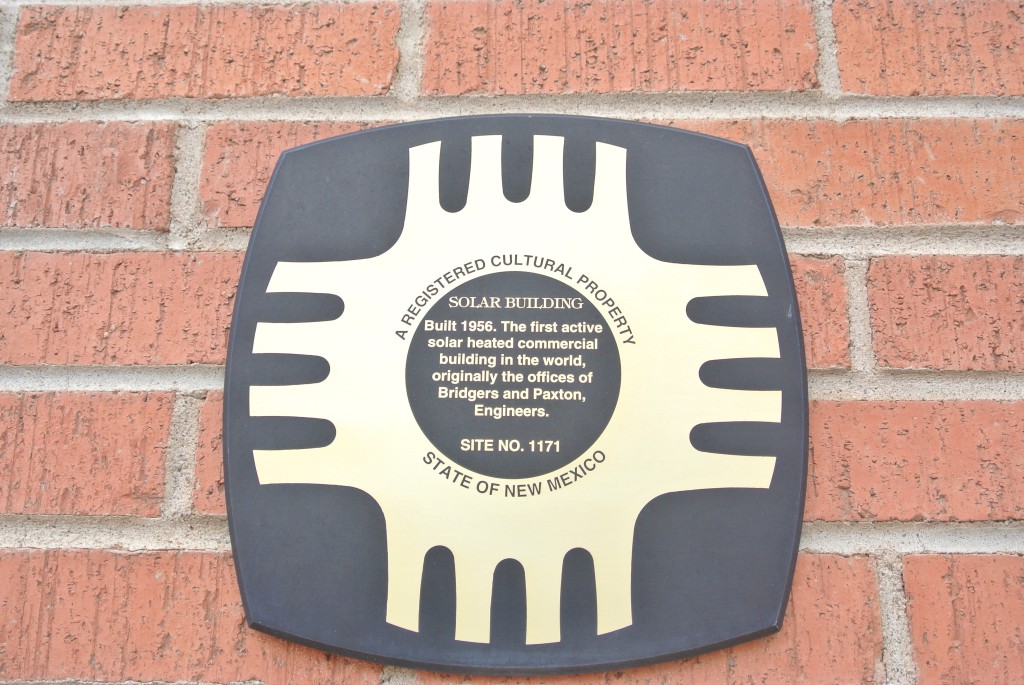
Unfortunately, the Solar Building’s fortunes changed over the following four decades. Today, its innovative heating system is no longer in use, and the building is currently unoccupied. Although it once stood as an engineering milestone, it is now an unmaintained and unused building. The building’s systems are old and it seems evident that the costs to maintain them are too great. The solar panels located on the angled southern façade are now covered by green sheet metal, rendering them essentially non-existent.
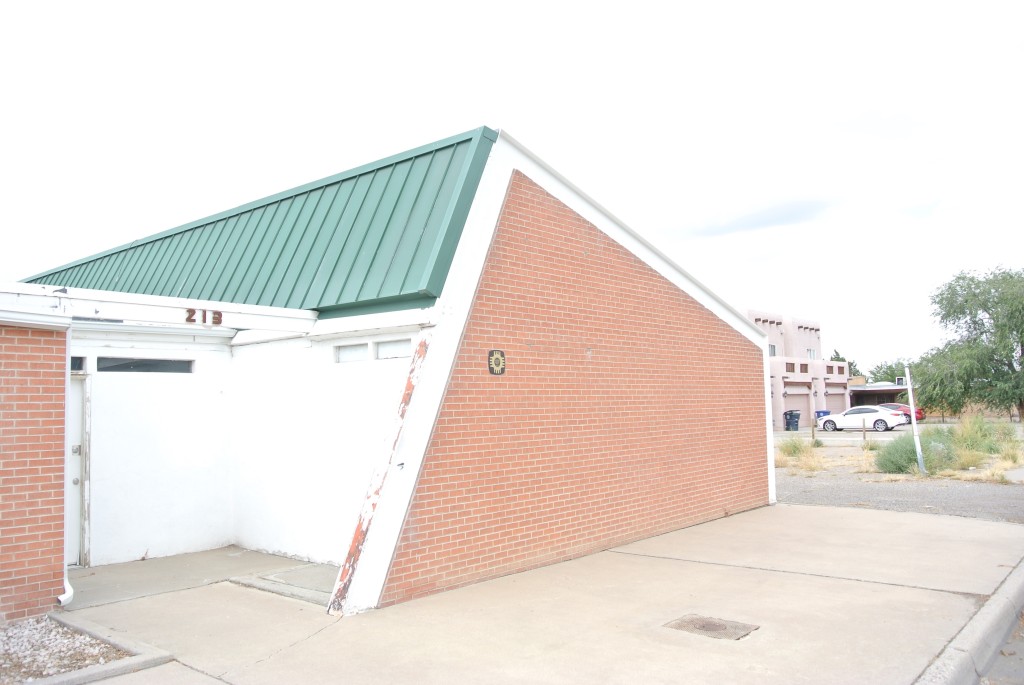
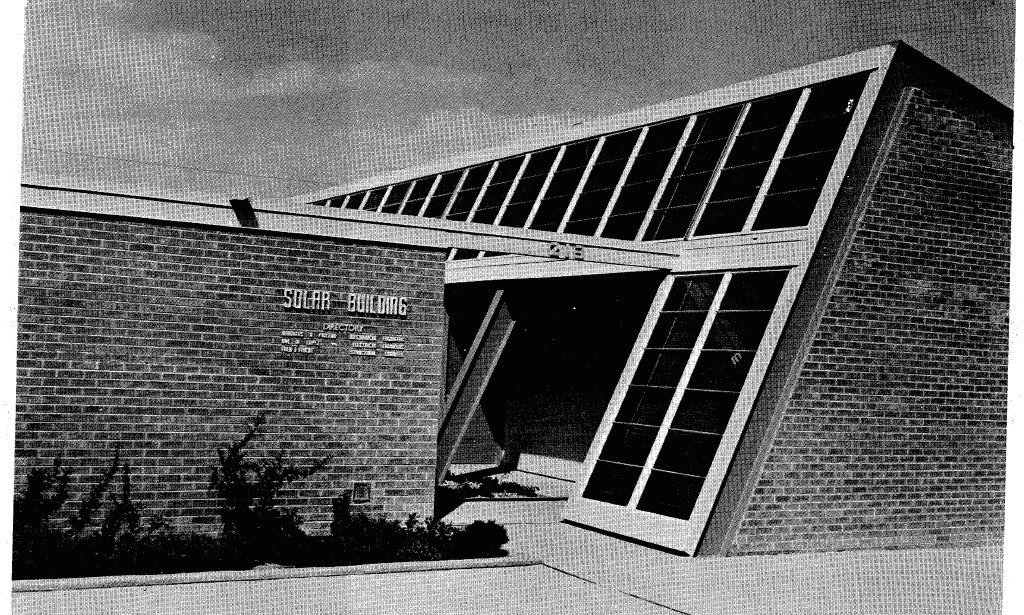
Nonetheless, if one looks closely, the Solar Building stands as a reminder of the potential for renewable energy, especially in New Mexico. It also serves as a reminder of the economic and social boom that occurred in the United States after the end of World War II, a boom that transformed Albuquerque. The engineering milestone created here paved the way for further renewable energy developments and experimentation in the United States. The war acted as a catalyst for ideas like this one and provided an environment that encouraged these scientific developments. However, the postwar boom in America also inhibited the success of the Solar Building to a certain extent, as the costs associated with operating and replicating it were seen as inessential in a time of plenty. It was not until the oil crisis of the mid-1970s that this building’s achievement received its due recognition. The Solar Building was an indicator of the capabilities of the United States at mid-century and anticipated the inventions that engineers would turn to in the years that followed, inventions that in our present era of climate change have attracted renewed attention. It is for this reason that the Solar Building was a success.
- “Solar Building,” ca. 1974, accessed October 24, 2015, http://www.earthalert.org/B_P%20Solar%20Building%20Brochures.pdf.
- Ibid.
- Ibid.; “213 Truman, N.E.,” ca. 1956, accessed October 24, 2015, http://www.earthalert.org/B_P%20Solar%20Building%20Brochures.pdf.
- “Warm Winter Behind Glass,” Life, 17 December 1956, 71.
- “Albuquerque Solar Building Tests Radiant – Heat System,” Popular Mechanics, November 1957, 157.
- “Solar Building,” ca. 1974; Stanley and Wright. Documentation Drawings for Bridgers and Paxton Solar Building, 1955-63, Stack 13, Drawers 1, 2, and 3, George S. Wright Architectual Drawings and Plans (SWA Wright Drawings), Center for Southwest Research and Special Collections, University of New Mexico, Albuquerque, NM.
- Solar Energy Utilization, “Solar Buildings of New Mexico (Funding Type),” Box 8, Folder 20, New Mexico Solar Energy Association Records (MSS 512 BC), Center for Southwest Research and Special Collections, University of New Mexico, Albuquerque, NM; “Solar Building,” ca. 1974.
2 thoughts on “Solar Building”
Thank you for writing about this important part of Albuquerque and solar heating history. Don Paxton was my grandfather and I remember visiting his building as a child and learning of it being a solar energy “first.” What I didn’t realize was at the time those memories were made, the solar heating component was no longer in use. I am sad to see the iconic panels covered up and that the building is virtually abandoned. You are spot-on to recognize that Don Paxton and Frank Bridgers were ahead of their time, and that our continued careless disregard for taking advantage of innovative clean energy solutions will always be trumped by the availability of cheap, dirty energy sources.
I was employed by Frank Bridgers (Phoenix Office) for 25 years starting in March 1986 untill by retirement
in June 2010 and for the first six year it was just Frank, Melissa Wilson (Frank’s secretary) and myself in
the Phoenix office. Those were the best working years of my life. Mr. B (that’s what I called him) and I
did large projects over those six years and Melissa would type the specifications (Mr. B relied heavily on
Melissa for all tasks in the office.) take appointments, airfare tickets etc. In the first part of 1987
Mr. B started bring in large projects for example, complete redesigned of the chilled water system at ASU, new central plant at ASU west, superstition spring mall w/ thermal storage in Mesa, Az, complete
resign of fashion square mall in Scottsdale, Az., new phoenix city hall and parking structure w/ themal
storage down town phoenix, neiman marcus at fashion square mall in Scottsdale AZ, and on and on.
Mr. B would take Melissa and I to lunch every day except Friday – at noon he was gone to play golf.
Mr. B would try to hile his golf shirt under his tie….we knew better.
Mr. Bridges was an honest and brilliant man and was always concerned about his employees.
Melissa and I miss you Mr. Bridgers.
Comments are closed.